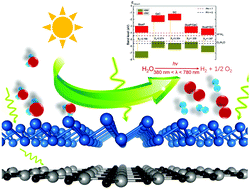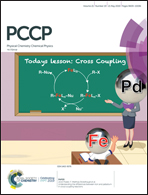Using van der Waals heterostructures based on two-dimensional blue phosphorus and XC (X = Ge, Si) for water-splitting photocatalysis: a first-principles study†
Abstract
Solar-powered production of hydrogen from water has been pursued as one of the solutions to the global energy crisis. Meanwhile, two-dimensional (2D) materials have attracted significant attention as photocatalysts. In this paper, the geometric structures, electronic band structures, band alignment, and optical properties of two novel van der Waals (vdW) heterostructures based on 2D blue phosphorus (BlueP) and 2D XC (X = Ge, Si) were systematically explored using first-principles calculations. We found that both BlueP/GeC and BlueP/SiC vdW heterostructures possess type-II band structures, which can continuously separate the photogenerated electron–hole pairs. The calculated band-edge positions suggest that the BlueP/SiC and BlueP/GeC vdW heterostructures act as potential photocatalysts for water-splitting at pH 0 and pH 7, respectively. Furthermore, XC acts as an electron-donating layer in the BlueP/XC vdW heterostructure, and the potential drop across the interface can generate a large built-in electric field across the interface; this electric field plays a crucial role in preventing the recombination of photogenerated charges. Finally, the optical properties of the BlueP/XC vdW heterostructures demonstrate that they have excellent ability to capture visible light, making them promising high-performance photocatalysts for water splitting.



 Please wait while we load your content...
Please wait while we load your content...